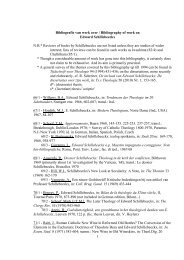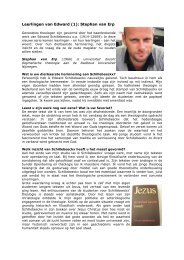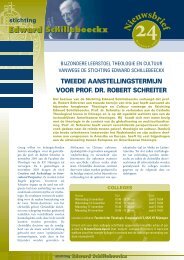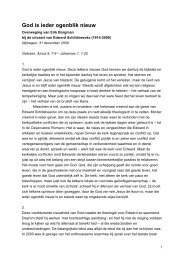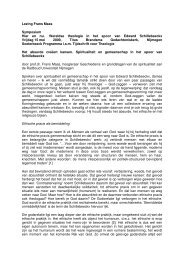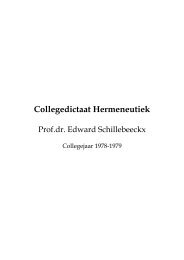Hans Hamers - Stichting Edward Schillebeeckx
Hans Hamers - Stichting Edward Schillebeeckx
Hans Hamers - Stichting Edward Schillebeeckx
You also want an ePaper? Increase the reach of your titles
YUMPU automatically turns print PDFs into web optimized ePapers that Google loves.
non-religious patient. For the religious patient we pose the question how Christian faith<br />
contributes to this process.<br />
3.2 Negative contrast experience<br />
A negative contrast experience forms the condition for a cognitive contact with God, besides<br />
or on/in the mystical aspect of faith. The negative contrast experience is rooted in the ethical<br />
praxis of humanizing unjust situations. In an negative contrast experience ‘no’ is said to the<br />
unjust world as it is. It is a basic experience accessible to all humans. <strong>Schillebeeckx</strong><br />
considers a negative contrast experience as a seedbed for cognitive experience of God. He<br />
recognizes the possibilities of a negative contrast experience in a secularized society, as a<br />
positive power to humanize the world. It is a critical negativity. It establishes a social<br />
function. 24<br />
A negative contrast experience has a negative side, the experience of unjustness, suffering,<br />
and illness. To this negative element a positive element is attached. The positive element is<br />
meant to be the situation that is not actual, that has to come, that can be dreamed about,<br />
hoped for, and sought after: an unrealized future. The positive element cannot be perceived<br />
as real, it is unrealized. So a negative contrast experience is not simply an experience of a<br />
negative happening, e.g. suffering. Kennedy summarizes: the negative side is the disordered<br />
nature of human existence and suffering. . “A sense of indignation eventually emerges from<br />
within such a negative experience: the very experience of debilitating suffering contrasts<br />
with a more worthy and human situation envisaged in the midst of suffering; and the<br />
perception of contrast which triggers a sense of indignation which refuses to submit to the<br />
inanity of suffering. The sense of indignation is associated with an incipient awareness of<br />
hope which prompts a prophetic protest against the causes of suffering. And so, a negative<br />
contrast experience militates against what should not be, on the basis of a hope what should<br />
be.” A negative contrast experience ‘is actually a double edged experience linked to the<br />
notion of prophecy. 25<br />
So what brings us this notion of negative contrast experience? To me it seems that<br />
<strong>Schillebeeckx</strong> meant this notion of negative contrast experience as a potential conception of<br />
dynamics of faith or religious dynamics, i.e. how the human experience and the<br />
consciousness of God come together in real mundane life. Because it is accessible for all<br />
humans, in the practice of spiritual care, one might expect that patients express this ‘no’ with<br />
regard to what they experience (observe) as suffering, being unjust social political situations,<br />
or conditions of physical crisis and illness. In a way this is the case, and the ‘no’ can be<br />
heard in the stories of patients. What about the positive side, the hope for that what should<br />
be? Kennedy uses the word ‘prophecy’, implying a notion of hope and critical expression. Is<br />
24 Kennedy, P., pp. 127-128<br />
25 Ibid. pp. 127-129<br />
9



